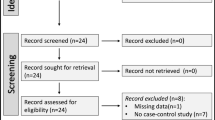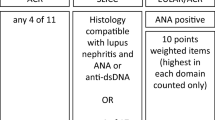Abstract
We wanted to see whether the active inflammation in Behcet’s disease (BD) can cause a thrombotic disorder by decreasing the protein S (PS) activity, and we evaluated the relationship between the decreased PS activity and the disease activity of BD. We included 122 patients with BD whose PS activity levels were measured. In 51 patients, the PS activity was measured again when there were changes in the number of items of “The Behcet’s Disease Current Activity Form (BDCAF)”. The thrombosis rate was 2.5% (3/122), and the PS activity was low in all three of the patients with thrombosis. The incidence of low PS activity in the total 122 BD patients was 27% (33/122). The incidence of the low PS activity in the active BD patients was 33.7% (31/92), and this was significantly more frequent than in the inactive BD patients, (6.7%, 2/30) (χ2-test, P value = 0.0038). The decrease of PS activity had good correlation with the increase of the number of BDCAF items (r = −0.351, P value = 0.012). The PS activity decrease is related to the BD activity. The low PS activity can be the risk factor for thrombotic disorder and also the activity marker for BD and other inflammatory diseases.

Similar content being viewed by others
References
Kaklamani VG, Vaiopoulos G, Kaklamanis PG (1998) Behcet’s disease. Semin Arthritis Rheum 27:197–217
Kluft C, Michiels JJ, Wijngaards G (1980) Factual or artificial inhibition of fibrinolysis and the occurrence of venous thrombosis in 3 cases of Behcet’s disease. Scand J Haematol 25:423–430
Koc Y, Gullu I, Akpek G, Akpolat T, Kiraz S, Batman F et al (1992) Vascular involvement in Behcet’s disease. J Rheumatol 19:402–410
Lie JT (1992) Vascular involvement in Behcet’s disease: arterial and venous and vessels of all sizes. J Rheumatol 19:341–343
Wechsler B, Vidailhet M, Piette JC, Bousser MG, Dell IB, Blentry O et al (1992) Cerebral venous thrombosis in Behcet’s disease: clinical study and long-term follow-up of 25 cases. Neurol 42:614–618
Hampton KK, Chamberlain MA, Menon DK, Davis JA (1991) Coagulation and fibrinolytic activity in Behcet’s disease. Thromb Haemost 66:292–294
Ozoran K, Duzgun N, Gurler A, Tutkak H, Tokgoz G (1995) Plasma von Willebrand factor, tissue plasminogen activator, plasminogen activator inhibitor, and antithrombin III levels in Behcet’s disease. Scand J Rheumatol 24:376–382
Oner AF, Gurgey A, Gurler A, Mesci L (1998) Factor V Leiden mutation in patients with Behcet’s disease. J Rheumatol 25:496–498
Gul A, Ozbek U, Ozturk C, Inanc M, Konkce M, Ozcelik T (1996) Coagulation factor V mutation increases the risk of venous thrombosis in Behcet’s disease. Br J Rheumatol 35:1178–1180
Mader R, Ziv M, Adawi M, Mader R, Lavi I (1992) Thrombophilic factors and their relation to thromboembolic and other clinical manifestations in Behcet’s disease. J Rheumatol 26:2404–2408
Sengul N, Demirer S, Yerdel MA, Terzioglu G, Akin B, Gurler A et al (2000) Comparison of coagulation parameters for healthy subject and Behcet’s disease patients with and without vascular involvement. World J Surg 24:1584–1588
Demier S, Sengul N, Yerder MA, Tuzuner A, Ulus AT, Gurler A et al (2000) Haemostatis in patients with Behcet’s disease. Eur J Vasc Endovasc Surg 19:570–574
Borgel D, Gandrille S, Aiach M (1997) Protein S deficiency. Thromb Haemost 78:351–356
Lee JH, Kim SW, Kim JS (2000) Sagittal sinus thrombosis associated with transient free protein S deficiency after l-asparaginase treatment: case report and review of the literature. Clin Neurol Neurosurg 102:33–36
D’Angelo A, Valle PD, Crippa L, Pattarini E, Grimaldi L, D’Angelo SV (1993) Autoimmune protein S deficiency in a boy with severe thromboemblimc disease. N Engl J med 328:1753–1757
Stahl CP, Wideman CS, Spira TJ, Haff EC, Hixon GJ, Evatt BL (1993) Protein S deficiency in men with long-term human immunodeficiency virus infection. Blood 81:1801–1807
Nguyen P, Reynaud J, Pouzol P, Munzer M, Richard O, Francois P (1994) Varicella and thrombotic complications associated with transient protein C and protein S deficiencies in children. Eur J Pediatr 153:646–649
Deitcher SR, Erban JK, Limentani SA (1996) Acquired free protein S deficiency associated with multiple myeloma: a case report. Am J Hematol 51:319–323
Song KS, Park YS, Kim HK (2000) Prevalence of anti-protein S antibodies in patients with systemic lupus erythematosus. Arthritis Rheum 43:557–560
International Study Group for Behcet’s Disease (1990) Criteria for diagnosis of Behcet’s disease. Lancet 335:1078–1080
Lawton G, Bhakta BB, Chamberlain MA, Tennant A (2004) The Behcet’s Disease activity index. Rheumatol 43:73–78
Lundwall A, Dackowski W, Cohen E, Shaffer M, Mahr A, Dahlback B et al (1986) Isolation and sequence of the cDNA for human protein S, a regulator of blood coagulation. Proc Natl Acad Sci USA 83:6716–6720
Webb JH, Blom AM, Dahlback B (2002) Vitamin K-dependent protein S localizing complement regulator C4b-binding protein to the surface of apoptotic cells. J Immunol 169:2580–2586
Anderson HA, Maylock CA, Williams JA, Paweletz CP, Shu H, Shacter E (2003) Serum-derived protein S binds to phosphatidylserine and stimulates the phagocytosis of apoptotic cells. Nat immunol 4:87–91
Ohkohchi K, Tornuki W, Tagami H (1989) Plasma concentration of complement-modulation proteins (C1 inhibitor, C4 binding protein, factor H and factor I) in inflammatory dermatoses with special reference to psoriasis. Dermatologica 179(Suppl 1):30–34
Kim HA, Choi KW, Song YW (1997) Arthropathy in Behcet’s disease. Scand J Rheumatol 26:125–129
Lee YJ, Kang SW, Yang JI, Choi YM, Sheen D, Lee EB et al (2002) Coagulation parameters and plasma total homocysteine levels in Behcet’s disease. Thromb Res 106:19–24
Ozatli D, Sayinalp N, Buyukasik Y, Karakus S, Haznedaroglu IC, Kirazli S et al (2002) Unchanged global fibrinolytic capacity despite increased factor VIIa activity in Behcet’s disease: evidence of a prethrombotic state. Rheumatol Int 21:137–140
Yazici C, Kose K, Calis M, Demlr M, Kirnap M, Ates F (2004) Increased advanced oxidation protein products in Behcet’s disease: a new activity marker? Br J Dermatol 151:105–111
Duzgun N, Ayaslioglu E, Tutkak H (2004) Serum soluble CD30 levels in Behcet’s disease. Clin Exp Rheumatol 22(Suppl 34):S17–20
Ozoran K, Duzgun N, Tutkak H, Gurler A, Tokgoz G (1996) Fibronectin and circulation immune complexes in Behcet’s disease. Rheumatol Int 15:221–224
Chang HK, Cheon KS (2002) The clinical significance of a pathergy reaction in patients with Behcet’s disease. J Korean Med Sci 17:371–374
Hamuryndan V, Fresko I, Direskeneli H, Tenant MJ, Yurdakul S, Akoglu T et al (1999) Evaluation of the Turkish translation of a disease activity form for Behcet’s syndrome. Rheumatol 38:374–376
Bhakta BB, Brennan P, James TE, Chamberlain MA, Noble BA, Silman AJ (1999) Behcet’s disease: evaluation of a new instrument to measure clinical activity. Rheumatol 38:728–733
Author information
Authors and Affiliations
Corresponding author
Additional information
This work was supported by Inha University Research Grant.
Rights and permissions
About this article
Cite this article
Kwon, S.R., Lim, M.J., Park, S.G. et al. Decreased protein S activity is related to the disease activity of Behcet’s disease. Rheumatol Int 27, 39–43 (2006). https://doi.org/10.1007/s00296-006-0214-4
Received:
Accepted:
Published:
Issue Date:
DOI: https://doi.org/10.1007/s00296-006-0214-4




